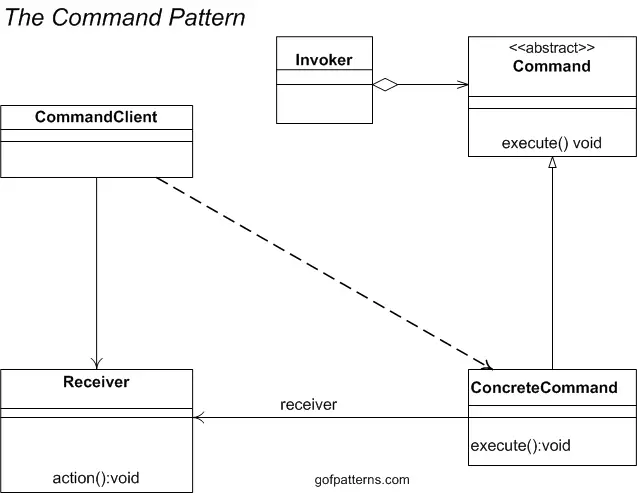Command Pattern
The Command pattern encapsulates a request in an object, which enables you to store the command, pass the command to a method, and return the command like any other object.
The figure below illustrates the Command Pattern.
The figure below illustrates the Command Pattern.

Benefits of the Command Pattern
Question: What are the benefits of the Command Pattern when used in software development?
The Command Pattern, a behavioral design pattern in the realm of software engineering, provides numerous advantages when appropriately applied to software development. This pattern encapsulates requests as objects, thereby allowing clients to issue requests without knowing anything about the request's operation or the receiving object. The benefits of the Command Pattern are manifold, including:
The Command Pattern is an advantageous tool for developers aiming to develop systems that are robust, flexible, and extensible. The ability to manage operations in a more abstract and encapsulated manner allows for greater control and potential in system design. However, it's worth noting that while the Command Pattern offers numerous benefits, it may not be suitable for all circumstances. The value of its use depends on the specific requirements and constraints of the project at hand. Therefore, it's always essential to assess the design pattern's appropriateness to the situation before applying it.
The Command Pattern, a behavioral design pattern in the realm of software engineering, provides numerous advantages when appropriately applied to software development. This pattern encapsulates requests as objects, thereby allowing clients to issue requests without knowing anything about the request's operation or the receiving object. The benefits of the Command Pattern are manifold, including:
- Decoupling: The Command Pattern decouples the sender and receiver of an action by focusing on the abstraction of the operation itself. The sender (client) doesn't need to know the details of how the operation is carried out or who performs it. This decoupling aids in writing cleaner, more modular code, improving maintainability.
- Undo/Redo Operations: The pattern allows easy implementation of the undo and redo operations. The command object knows the receiver and binds the receiver and its action. By maintaining a history of executed commands, it's possible to move backward (undo) or forward (redo) through this history.
- Parallelism and Asynchronous Invocation: The pattern supports parallelism as commands can be invoked in an asynchronous manner. This is particularly useful in multi-threaded applications where commands can be run in separate threads. The asynchronous nature also allows for non-blocking user interfaces, leading to smoother user experience.
- Queue or Schedule Requests: Command objects can be stored and executed at different times according to the need of the system. The pattern thus allows scheduling, prioritizing, and managing of requests. For example, in a job queue system, you can postpone command execution to the idle time or specific time periods.
- Macro Commands: With the Command Pattern, complex commands can be composed of simpler commands, known as macro commands. This encapsulation of multiple commands into a single object reduces the complexity and enhances the robustness of the system.
- Extensibility: The Command Pattern makes the system more extensible by enabling new commands to be added without changing the existing codebase, thereby adhering to the open-closed principle. This is accomplished by defining a common interface for all commands, allowing the system to support new commands at runtime.
The Command Pattern is an advantageous tool for developers aiming to develop systems that are robust, flexible, and extensible. The ability to manage operations in a more abstract and encapsulated manner allows for greater control and potential in system design. However, it's worth noting that while the Command Pattern offers numerous benefits, it may not be suitable for all circumstances. The value of its use depends on the specific requirements and constraints of the project at hand. Therefore, it's always essential to assess the design pattern's appropriateness to the situation before applying it.
The following lists the benefits of using the Command Pattern:
- Separates the object that invokes the operation from the one that knows how to perform it.
- It's easy to add new commands, because you don't have to change existing classes.
When to Use the Command Pattern:
You should use the Command pattern when:
- You want to parameterize objects by an action to perform.
- You specify, queue, and execute requests at different times.
- You must support undo, logging, or transactions
Command Pattern in Java